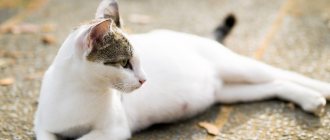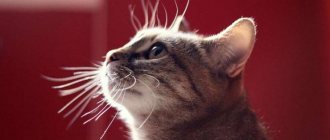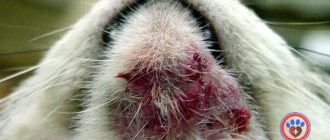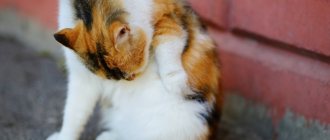Snoring and wheezing in brachycephalic cats
Brachycephalic cats are cats whose head width reaches up to 75% of its length. Such animals have a shortened skull and a flattened muzzle. Brachycephalic breeds include Scottish, British, Persian, Himalayan and exotic breeds. Such cats have certain features in the structure of the muzzle and larynx that interfere with the passage of air through the nasopharynx. This makes it difficult to breathe, causing wheezing and loud snoring, which are considered normal for brachycephalic breeds.
Features of the anatomy of brachycephalic cats:
Due to such structural features, cats of brachycephalic breeds almost always sniffle and grunt in their sleep from an early age. Don't worry if your cat has been breathing like this since childhood. The alarm should only be sounded when snoring at night develops into suffocation. Brachycephals are more likely than other breeds to suffer from respiratory diseases, so a sharp change in the timbre of snoring is a reason to contact a veterinarian.
Natural predisposition
Among the many cat breeds, there are brachycephalic varieties, which have a skull structure that is atypical for other species. These are the well-known Persian and British cats, as well as their mestizos, which are characterized by a “flat” muzzle and a shortened head shape. Due to abnormal physiology, such animals have :
- frequent colds during the cold season;
- difficulty breathing in hot weather;
- low filtration ability, so dust and other small particles have a sharp irritating effect;
- violations of the structure of the soft palate, which interfere with normal air flow.
© shutterstock
A cat's characteristic grunt accompanies each of the described situations. In everyday life they snore and wheeze. A cat may sneeze when it has a cold or in dusty rooms. The abnormal shape of the palate not only makes breathing difficult, but also provokes vomiting. The only solution to the problem can be surgery.
Pathological causes of snoring
Infectious diseases of the respiratory organs
Why does a cat snore in his sleep? This can also be caused by pathological reasons. Snoring can often be caused by infectious diseases of the respiratory organs: bronchitis, pneumonia, pneumonia. A cat can become hypothermic if it has been in the cold for a long time, slept under a powerful air conditioner, sat in a draft, and become ill.
Dry air, especially in winter, during the heating season, dries out the nasopharyngeal mucosa of a pet. Viruses and bacteria easily enter the body because local immunity cannot cope with them. A runny nose begins - mucus forms in the nose, clogging the nasal passages, so air passes through with difficulty and with a characteristic sound. Other symptoms of a respiratory infection: coughing, sneezing, blue gums. Wheezing when inhaling, crackling when exhaling is a sign of pneumonia. The animal needs to be shown to a veterinarian.
Respiratory diseases of a non-infectious nature
The cause of snoring can be non-infectious pathologies. Most often this is swelling of the nasopharyngeal mucosa and asthmatic bronchospasm. Swelling of the larynx is a consequence of an allergic reaction that was not noticed in time by the owner. A cat may be allergic to new food, cleaning products, or plants. With swelling, a hoarse sound occurs when inhaling, similar to snoring. This may later be accompanied by wheezing. It is observed not only in sleep, but also during wakefulness. This condition is dangerous and can threaten the life of the cat.
Another threatening pathology of the respiratory system is asthma. The cat experiences attacks of suffocation, accompanied by characteristic sounds. A cough may occur, which, due to spasms, causes a gag reflex. Later shortness of breath, apathy and poor appetite appear. The first stage of asthma (moderate) may remain unrecognized by the owner for a long time. The cat periodically coughs and snores at night, but overall remains in good health. With a suffocating cough, respiratory failure develops - at this stage the animal must be urgently taken to the veterinarian.
Treatment of rhinitis
A runny nose and inflammation of the mucous membrane should be treated promptly
, there is no need to wait for complications for your pet to become deaf or for inflammation to spread to other respiratory organs.
If rhinitis occurs due to an infection, bacterial or viral, the veterinarian prescribes antibiotics, antibacterial drugs, taking into account the animal’s age and breed
It is important to strictly adhere to the instructions and carry out the course of treatment to the end, even if there is no discharge and the nose can breathe freely. The course of treatment for rhinitis may include antipyretic, anti-inflammatory, and sedative drugs. Sometimes the veterinarian recommends rinsing the animal’s nose to ease its breathing and general condition. Inhalations with essential oils are effective for rhinitis; you just need to strictly follow the dosage of oil drops. The nose is also warmed up with warm sand or salt wrapped in a clean cloth. If your pet has dry skin around its nose, you can constantly moisturize it with baby cream or Vaseline.
If you need to clear your nose, you should act very carefully and carefully.
, following the advice of experts. Wounds can not only cause pain, but also become a source of infection
. You can clean the crusts with a damp cotton swab.
Are cats prone to snoring?
Cats are much less susceptible to this phenomenon than dogs or even humans. However, certain breeds of cats with short, flat faces are prone to snoring. They may snore quite loudly in their sleep. These are Persian, British, Scottish, Himalayan, all kinds of exotics. For these breeds, snoring during sleep is normal and is called brachycephalic syndrome. It occurs due to short sinuses.
In some cases, brachycephalic syndrome can cause surgery when the cat becomes very difficult to breathe and snores. Beauty, as they say, requires sacrifice. Breed characteristics in domestic cats are sometimes too pronounced and prevent them from enjoying a full life.
Cats with a normal muzzle shape are another matter, especially in a situation where snoring appears suddenly. However, you need to know that diseases, one of the symptoms of which is snoring, are highly treatable, so there is no need to panic. However, it is imperative to get rid of this unpleasant phenomenon.
Causes of stuffy nose in cats
The most common cause of runny nose in cats is an allergic reaction to chemicals.
Among the most common causes of runny nose in cats are the following:
- Allergic reactions
. Often occurs due to detergents, perfume, pollen, and other substances that irritate the mucous membranes. - Viral, fungal and bacterial infections.
- Hypothermia or eating food that is too cold.
- Inhaling hot air.
- Inhalation of toxic fumes.
- Foreign body in the nasal passage.
- Tumors in the nasopharynx.
Symptoms of a runny nose in cats
The most common manifestations of a runny nose are:
- Heavy breathing, the cat often breathes through its mouth.
- Itching and redness of the skin on the nose.
- Frequent snorting.
- Enlarged lymph nodes under the lower jaw.
- Nasal discharge.
If your cat has green, brown or yellow discharge from the nose, it means your pet has purulent rhinitis.
If you notice green, brown or yellow discharge from your cat's nose, this means that your pet has purulent rhinitis. In this case, contact your veterinarian immediately.
What diseases can cause a cat to snore?
Cat snoring is not an independent disease, but a symptom of another disease that is completely treatable. Here are the most common reasons :
There are many other diseases that can cause snoring as a symptom. For example, urolithiasis, polyps, paralysis and many other reasons. The reasons why a cat snores in its sleep are varied. The list is very large, so the cat owner simply cannot figure it out on his own, without special veterinary education and experience. Therefore, you must definitely show your cat to a specialist, so as not to later regret the wasted time.
Video about rhinotracheitis in cats
Thematic materials:
Why do you dream of flowers: interpretation according to various dream books for men and women Purified turpentine (pinene) Nutmeg beneficial properties and contraindications How to cook delicious flounder in a frying pan step-by-step recipe Features of growing statice from seeds: when to plant Statice supreme growing from seeds Men's diet for weight loss - a nutrition strategy to remove belly fat Nutmeg - composition, benefits and drug properties How to cook flounder fillet in briquettes?
103583
If you notice an error, select a piece of text and press Ctrl+Enter
What treatment can a veterinarian prescribe?
First, the veterinarian must conduct a complete examination of the cat, including the throat and nasopharynx. If the reason is not so obvious or it is necessary to clarify in more detail the extent of the damage, an x-ray will be prescribed. In some cases, a blood test will be required. In difficult cases, when special examination is required, the animal may be given anesthesia.
Once the reason why the cat snores in its sleep is determined, then treatment will be prescribed. These are pills and injections, IVs, diet. Sometimes it is necessary to use special ear swabs. They are used at the moment when the cat begins to fall asleep. In some cases, surgery will be required. Treatments and procedures must be supervised by a veterinarian.
Do not delay visiting a specialist if your cat begins to snore in its sleep. The health of a cat means the owner’s peace of mind, his good mood and joy for all family members, especially the little ones. Therefore, you need to take care of the well-being of your family first of all.
Source
Treating nasal congestion in cats at home
Any owner's heart will break at the sight of a suffering pet. Therefore, it is necessary to know that a person can help his pet at home. To do this you need:
If your cat's runny nose is caused by hypothermia, you need to provide her with warmth and rest.
If you do not know the exact cause of your pet's rhinitis, then the best option would be to consult a specialist. The veterinarian will determine the cause of the animal’s runny nose and draw up a comprehensive treatment plan using various medications.
What happens if your pet's nasal congestion is not treated?
A runny nose can develop into purulent rhinitis
When the mucous membranes in the nasal passage become inflamed, the cat does not receive the proper amount of oxygen.
Because of this, the functioning of all organs of the animal may deteriorate. After this, the pet will become passive, the appetite will worsen and the entire body will be exhausted. If acute rhinitis in a pet is not treated, it can develop into chronic rhinitis, which requires long-term treatment and increased care.
The cat grunts when breathing: reasons
Cats are capable of making a wide variety of sounds: from rhythmic purring and gentle meows to prolonged loud howls and snake hisses. The “sound background” depends on the physiological state and emotions, well-being and needs of the pet. Sick cats may cough, sneeze, wheeze, and sniffle. But sometimes the animal makes a sound when breathing, reminiscent of a short snore or grunt. What are the reasons for such a reaction? And is the “grunting state” dangerous to the pet’s health?
Diagnosis of the condition
The cat is breathing with its mouth open: what is the reason and what can be done
If the owner notices that the cat is breathing with difficulty, is very weak, apathetic and does not respond to anything, has severe injuries, has lost weight or has a serious illness (asthma, heart disease, etc.), it is necessary to urgently visit a veterinarian who has the necessary equipment and experience in providing assistance.
A weak, lethargic cat with trouble breathing should definitely be shown to a veterinary clinic.
During the trip, you need to check the cat’s breathing; if you can’t hear it, you can put a mirror against its nose or mouth. A foggy surface is evidence of breathing. You should also check the heartbeat in the chest and the pulse on the inside of the thigh. If breathing or heartbeat stops, you will have to start CPR yourself.
Pharyngeal (pharyngeal) reflex
This condition is also called “paroxysmal breathing” or “reverse sneezing.” It is not a disease, but it looks quite alarming and unusual.
Paroxysmal breathing is recorded not only in cats, but also in dogs and people.
According to felinologists, its cause is irritation of the soft palate, resulting in a kind of spasm. At the same time, the animal rests on its forelimbs, stretches its neck, arches its back and produces sounds reminiscent of a noisy short breath, sneezing, coughing and grunting at the same time.
Causes. The condition can be provoked by:
Progression and diagnosis. Usually the cat copes with an attack of reverse sneezing on its own, however, if the respiratory abnormality becomes more and more obvious, then perhaps the animal really is sick. In particular, a gradual increase in symptoms is caused by neoplasms growing in one or another part of the respiratory tract. The owner will be able to independently diagnose them only if the tumors become too large and manifest themselves externally, or enter the decay phase and begin to bleed. Ultrasound diagnostics and x-rays will help dispel all doubts.
Paroxysmal breathing
This is the name of an interesting pathology when a cat makes very strange sounds during attacks, which can be described as “something in between” sneezing, grunting and trying to inhale more air. How can you determine if your pet has this disorder? It's quite simple: the cat slightly bends its front legs, arches its back, and its eyes are wide open. We have already written about the sounds it makes at this time.
What should the owner do? After all, the cat, it seems, is far from delighted with his condition! No matter how strange it may seem to you, the first thing you should do is calm down. Yes, paroxysmal breathing does not look very pleasant from the outside, but in many cases it does not pose a real threat to the life and health of the animal
.
True, sometimes you should be wary:
If attacks, which were relatively rare and short-lived, acquire an unpleasant tendency to become more frequent.
During “oddities,” the cat begins to vomit, and sometimes blood clots can be easily seen in the vomit.
Your pet has begun to sleep very poorly and restlessly: the cat grunts through its nose, which is why it often wakes up. You need to take a closer look at it if your pet belongs to any of the brachycephalic breeds we have already mentioned.
In the latter case, it is possible that your pet needs the
operation we have already described to “shorten” the palatal tissues
. If everything is not so serious, but you want to help your pet, gently massage his throat after attacks, and also give him plenty of warm water. All this will soften irritated tissues and stop an attack of “grunting”.
A cat's wheezing and snoring indicate abnormalities in its body. They can be caused both by the characteristics of the breed and congenital pathologies, and by various diseases. If such symptoms occur, it is necessary to examine your pet. If there are no signs of deterioration in health, there is no reason to panic. If general malaise and other symptoms appear, the animal should be taken to a veterinarian.
Allergic manifestations
Allergies are common among tailed pets. An allergen entering the body during breathing provokes an immune system reaction characterized by irritation and inflammation of epithelial cells, swelling of the mucous membrane of the respiratory tract and accumulation of exudate in the bronchi. As a result, the cat:
Allergens:
Associated symptoms. Difficulty breathing due to allergies is accompanied by:
Nature of manifestations. The severity of respiratory allergic manifestations can vary and may include:
In the latter case, the animal suffers from episodic attacks of suffocation caused by bronchospasm, swelling of the respiratory tract mucosa and excessive mucus production by the bronchial epithelium. At such a moment, it seems that the animal cannot take a breath, breathing with wheezing and whistling.
Asthma most often affects adult cats aged 2 years and older.
Methods of therapy. To relieve allergy symptoms, the veterinarian prescribes antihistamines and corticosteroids, and for asthma, special aerosols. An allergic cat must be kept at a comfortable temperature with humidification, preventing the inhalation of dust, tobacco smoke and other substances hazardous to it.
Helminthiasis
An animal carrying parasitic worms can make unusual grunting sounds.
Toxocara. The development cycle of the Toxocara nematode begins with the cat swallowing food infested with larvae or eating the intermediate host of the parasite, which is:
Development in the body . In the intestine, the larva actively invades the blood vessel through the epithelial wall in order to enter the lungs with the bloodstream. Young parasites feed on the blood and tissues of the airways, causing severe irritation, difficult wheezing breathing and a reflex cough.
The damaging effect leads to the attachment of pathogenic bacteria that increase inflammation. With a cough, some of the larvae enter the oral cavity and are swallowed again, growing in the intestines into a mature worm. During the period of migration of larvae into the digestive tract, the cat may experience the urge to vomit.
Hookworm. Hookworm larvae cause hookworm disease by entering the cat’s body in several ways:
Development. The path of larvae that have penetrated through the skin into the blood lies in the respiratory tract, and then, when coughing, into the oral cavity.
After 3 weeks, swallowed parasite embryos grow in the intestines into adult individuals that feed on the blood of the host animal.
Clinical picture of helminthic infestation. Infection with helminths in a cat is indicated by:
Diagnosis and treatment. The diagnosis is based on laboratory tests of blood and feces. Having determined the type of helminth, anthelmintic drugs are prescribed in the required dose and, possibly, with repeated use.
Also watch the video of a cat breathing with wheezing:
Osteochondrodysplasia
The genetic disease is osteochondrodysplasia of Scottish fold cats (OSF), a common, incurable disease that affects the bones and joints of the animal. Caused by the presence of an individual gene for “loop ears”, which is specific to the Scottish Fold and Highland Fold. Diseases of Scottish Fold cats appear in newborn kittens in the first months of life.
OCD, a hereditary disease, is transmitted regardless of the sex of the animal from offspring to parents. To protect animals from the transmission of heredity, mating within the Scottish Fold and Highland Fold species is prohibited; interspecific mating is allowed only within the Scottish breed with straight-eared cats - Scottish Straight, Highland Straight. If you follow the rules of crossing, the risk of developing DCD is greatly reduced.
When OCD manifests itself, bone tissue grows around the joints, and the bones and cartilage of the entire spine skeleton, starting with the tail, and limbs are affected.
It is impossible to cure a gene disease at the present stage; measures are being taken to stop the development of the disease.
Symptoms
The disease osteochondrodysplasia of Scottish cats appears already in the first months after the birth of a kitten, in rare cases in adulthood. And if at first it is little noticeable, then it quickly progresses with age. Main symptoms to look out for:
- Sharp decrease in activity:
- Movement is difficult, the kitten does not jump, moves little;
- The gait changes, lameness is observed.
- There are obvious changes in appearance:
- Underdeveloped, twisted limbs with shorter hind legs, all joints are twisted;
- Increased head volume with a protruding jaw and crooked teeth;
- The short, almost unbending tail is motionless and thin at the base.
- The pet constantly experiences pain, sometimes severe.
If these signs are present, contact specialists. There they will make a correct diagnosis and prescribe treatment.
Treatment
To the veterinary clinic, in order to make a correct diagnosis of the Scottish fold cat and prescribe treatment:
- They study the cat's pedigree and conduct an initial examination of the animal. To verify the signs of OCD and understand what to do in the future, the following is prescribed:
- x-ray of limbs and spine;
- carry out anamnesis collection, biochemical analysis of blood and urine;
- a bone tissue sample is taken.
- When the diagnosis of osteochondrodysplasia is confirmed, supportive therapy and treatment are prescribed to make life easier and reduce pain:
- anti-inflammatory drugs;
- intra-articular injections of chondroprotectors “Chondroitin sulfate”, “Chondroitin” and “Glucosamine”
- It is recommended to regularly do a special massage that will improve blood circulation in the extremities;
If therapeutic treatment does not bring relief, it is prescribed for arthrosis or osteotomy - a surgical operation.
Important! Veterinarians first diagnosed osteochondrodysplasia in Scottish fold cats in 1971. Having finally become convinced of the incurability of the disease, specialists from felinological associations called on breeders in 2021, for humanitarian purposes, to stop breeding the breed, which is a type of frequent occurrence of musculoskeletal defects that lead to suffering and death of Scottish Fold and Highland Fold animals.











